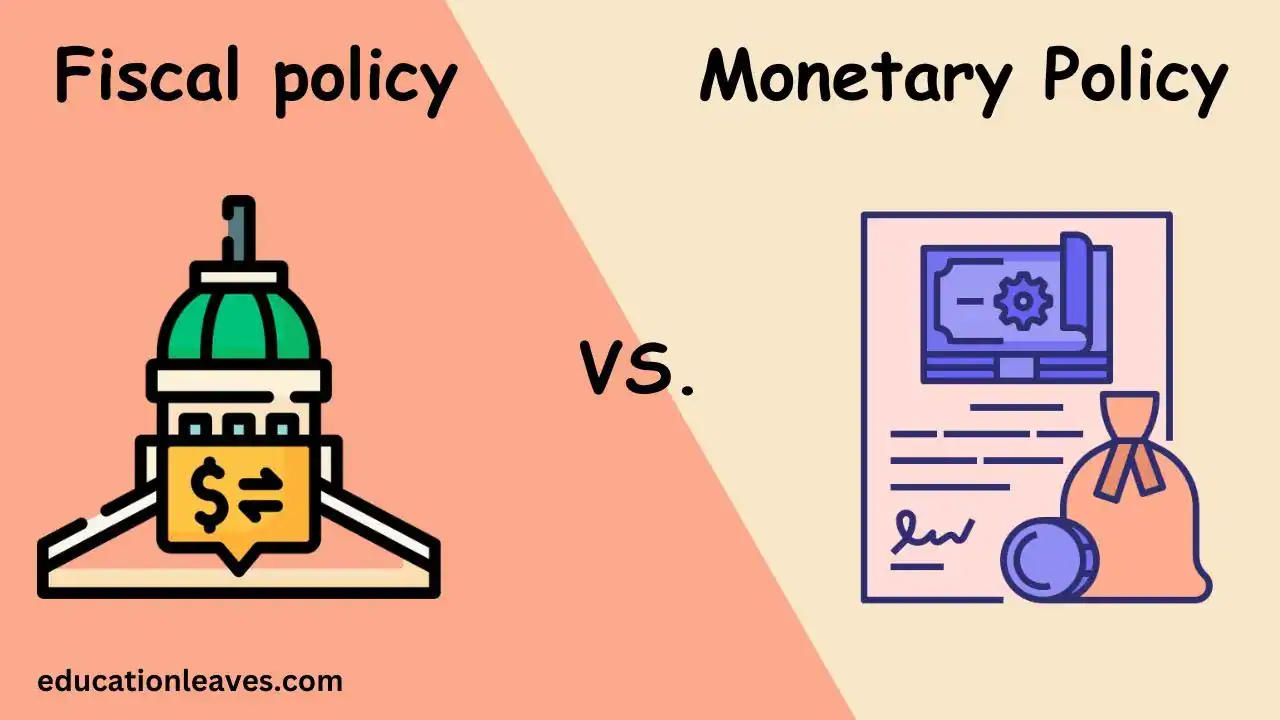Fiscal Policy vs. Monetary Policy: Both policies are crucial tools employed by governments and central banks to influence a nation’s economic direction. Both aim to stabilise the economy, curb inflation, foster growth, and reduce unemployment, but they differ in approach, objectives, and execution.
Let’s discuss the difference between fiscal policy and monetary policy.
What you are going to learn?
What Are Fiscal Policy and Monetary Policy?
Fiscal Policy:
Fiscal policy refers to the strategies and actions taken by the government through taxation and public expenditure to influence a nation’s economic activity. It aims to achieve objectives such as economic growth, reducing unemployment, and controlling inflation.
For example, increasing government spending during a slowdown can stimulate demand and boost economic activity, while raising taxes during a boom can help control inflation.
Monetary Policy:
Monetary policy is the process by which a country’s central bank regulates the money supply and interest rates to maintain economic stability and achieve specific goals like controlling inflation, stabilising the currency, and fostering economic growth. Tools like open market operations, changes in interest rates, and reserve requirements are commonly used to influence credit availability and demand in the economy.
Who Implements Them?
Fiscal Policy:
The government implements fiscal policy, more specifically, institutions like the Ministry of Finance or the Department of the Treasury do. These bodies are responsible for deciding on tax policies, government spending, and borrowing strategies. Their goal is to influence the economy by adjusting public revenues and expenditures to maintain growth, control inflation, and reduce unemployment.
Monetary Policy:
A country’s central bank or monetary authority manages monetary policy, for example, the Reserve Bank of India (RBI) or the U.S. Federal Reserve. These institutions control the money supply and interest rates to maintain price stability, regulate inflation, and ensure overall financial stability in the economy.
How Fiscal and Monetary Policies Shape the Economy
Fiscal Policy
Public Spending:
Governments use public spending to stimulate economic growth and improve the quality of life. This includes investing in infrastructure like roads, bridges, and power supply, as well as essential services such as education, healthcare, and social welfare. These investments not only create jobs but also build long-term economic capacity.
Taxation:
By adjusting tax rates, the government can influence consumer and business behaviour. Lowering taxes can leave more money in people’s hands, encouraging spending and investment. On the other hand, increasing taxes may help reduce inflation or raise revenue for public programs. Balance is crucial for economic stability.
Monetary Policy
Interest Rates:
Central banks control the base interest rate to manage borrowing and spending. When interest rates are lowered, loans become cheaper, encouraging businesses to invest and consumers to spend. Conversely, higher rates make borrowing costlier, which can slow down inflation and reduce overheating in the economy.
Open Market Operations (OMO):
This involves the central bank buying or selling government bonds in the open market. When the bank buys securities, it injects liquidity into the economy, making more money available for banks to lend. Selling securities does the opposite, pulling money out of circulation to control inflation or stabilise currency value.
Reserve Ratios:
Reserve requirements determine the minimum amount of money banks must hold in reserve and not lend out. A higher reserve ratio reduces the amount banks can lend, tightening the money supply. Lowering it allows banks to lend more, boosting credit and potentially spurring economic activity.
Tools and Techniques
Primary Goals
- Fiscal Policy:
- Drive economic growth through increased government expenditure.
- Generate employment opportunities by funding public projects.
- Address income disparities through progressive taxation policies.
- Monetary Policy:
- Maintain price stability by controlling inflation.
- Foster a stable currency and ensure smooth financial operations.
- Support steady economic expansion by regulating credit availability.
Direct vs. Indirect Impact
- Fiscal Policy: Directly affects the economy through changes in government spending and taxation. It can take time to implement due to legislative processes.
- Monetary Policy: Influences the economy indirectly by altering borrowing and lending behaviours. Its impact depends on how markets respond to changes in interest rates and liquidity.
Time Horizons
- Fiscal Policy: Typically focused on long-term objectives, as structural adjustments often take years to show results.
- Monetary Policy: More suited for short-term adjustments, addressing immediate economic challenges such as inflation or recession.
Flexibility and Speed
- Fiscal Policy: Less flexible because implementing changes often requires approval from lawmakers, which can delay action.
- Monetary Policy: More agile as central banks can swiftly adjust interest rates or undertake market interventions without legislative delays.
Real-World Examples
- Fiscal Policy: Governments worldwide implemented fiscal stimulus packages, including direct payments to citizens and increased public infrastructure spending, during the COVID-19 pandemic to counter economic slowdowns.
- Monetary Policy: Central banks reduced interest rates and injected liquidity into financial systems to prevent economic collapse during the same crisis.
Conclusion
Fiscal policy and monetary policy serve as complementary tools to guide an economy toward growth and stability. While fiscal policy involves direct government intervention through taxation and spending, monetary policy influences financial conditions indirectly by regulating the money supply and interest rates. A balanced combination of both is often necessary to achieve sustainable economic progress and resilience.

